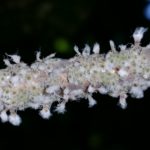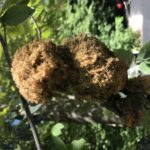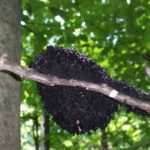
By Rich Niccum, Education Services Manager
As you walk the trails in early fall you may see white “fuzz” covering the leaves of beech trees. Upon closer inspection the fuzz looks alive, and that’s because it is! You are observing a fascinating insect called the beech blight aphid or the woolly beech aphid. This insect in the order Hemiptera forms dense colonies on small branches and the underside of leaves of American beech trees usually starting in mid-July. Heavily colonized tree branches and leaves appear to be covered with snow. As you observe the insect, touch the branch or leaf and watch what happens. The “snow” will appear to come alive as the aphids perform a defensive behavior by raising their posterior ends and swaying side to side. This action has also led the insect to earn the nickname the “Boogie-Woogie Aphid”. They gather en masse on the beech tree branches to feed, piercing the bark with their syringe-like mouth parts called stylets and sucking the sap out. The aphids do not usually damage the trees, but some die back may be seen on intensely colonized branches.
As you stand admiring the dancing aphids you may also notice that some of the leaves beneath them are covered in “soot”. Growing on the honeydew, or scat, that the aphids secrete is a fungus called Scorias spongiosa, also known affectionately as the beech aphid poop eater.
This sooty mold, unlike other species, is restricted to the American beech and the woolly beech aphid. Scorias spongiosa starts growing as a thin layer of yellow-brown tufts on the leaves and ground beneath the aphids. As more honeydew is secreted and accumulates the fungus grows larger and larger until it begins to resemble a large yellow sponge hanging off the tree. It even 

The relationship between the “Boogie Woogie Aphid” and the beech aphid poop-eater is one of those natural occurrences that goes unnoticed by many, but upon closer inspection is an incredibly fascinating part of our natural world. So next time you are out on the trail take a moment to notice the little things and marvel in the wonders of nature.







